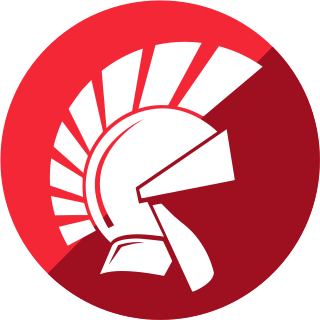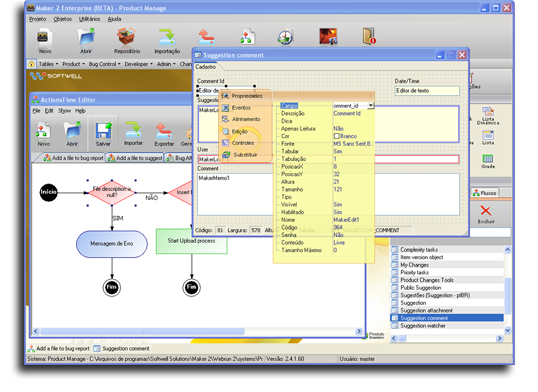An integrated development environment (IDE) is a software application that provides comprehensive facilities for software development. An IDE normally consists of at least a source-code editor, build automation tools, and a debugger. Some IDEs, such as IntelliJ IDEA, Eclipse and Lazarus contain the necessary compiler, interpreter or both; others, such as SharpDevelop, NetBeans do not.
FileMaker is a cross-platform relational database application developed by Claris International, a subsidiary of Apple Inc. It integrates a database engine with a graphical user interface (GUI) and security features, allowing users to visually modify a database. Versions for desktops, servers, iOS and web-delivery have been released.

Delphi is a general-purpose programming language and a software product that uses the Delphi dialect of the Object Pascal programming language and provides an integrated development environment (IDE) for rapid application development of desktop, mobile, web, and console software, currently developed and maintained by Embarcadero Technologies.

In computing, a visual programming language or block coding is a programming language that lets users create programs by manipulating program elements graphically rather than by specifying them textually. A VPL allows programming with visual expressions, spatial arrangements of text and graphic symbols, used either as elements of syntax or secondary notation. For example, many VPLs are based on the idea of "boxes and arrows", where boxes or other screen objects are treated as entities, connected by arrows, lines or arcs which represent relations.
Web development is the work involved in developing a website for the Internet or an intranet. Web development can range from developing a simple single static page of plain text to complex web applications, electronic businesses, and social network services. A more comprehensive list of tasks to which Web development commonly refers, may include Web engineering, Web design, Web content development, client liaison, client-side/server-side scripting, Web server and network security configuration, and e-commerce development.
Oracle Forms is a software product for creating screens that interact with an Oracle database. It has an IDE that includes an object navigator, property sheet, and code editor that uses PL/SQL. It was originally developed to run server-side in character-mode terminal sessions. It was ported to other platforms, including Windows, to function in a client–server environment. Later versions were ported to Java where it runs in a Java EE container and can integrate with Java, and web services that can be launched from a URL. Recent versions provide a means to run the forms from a desktop computer without requiring a browser.

Uniface is a low-code development and deployment platform for enterprise applications that can run in a large range of runtime environments, including mobile, mainframe, web, Service-oriented architecture (SOA), Windows, Java EE, and .NET. Uniface is used to create mission-critical applications.
Mobile app development is the act or process by which a mobile app is developed for one or more mobile devices, which can include personal digital assistants (PDA), enterprise digital assistants (EDA), or mobile phones. Such software applications are specifically designed to run on mobile devices, taking numerous hardware constraints into consideration. Common constraints include CPU architecture and speeds, available memory (RAM), limited data storage capacities, and considerable variation in displays and input methods. These applications can be pre-installed on phones during manufacturing or delivered as web applications, using server-side or client-side processing to provide an "application-like" experience within a web browser.
LINC is a fourth-generation programming language, used mostly on Unisys computer systems.
Omnis Studio is a rapid application development (RAD) tool that allows programmers and application developers to create enterprise, web, and mobile applications for Windows, Linux, and macOS personal computers and servers across all business sectors.
Morfik Technology Pty Ltd. is an Australian software company that was acquired by Altium in 2010.
The SQuirreL SQL Client is a database administration tool. It uses JDBC to allow users to explore and interact with databases via a JDBC driver. It provides an editor that offers code completion and syntax highlighting for standard SQL. It also provides a plugin architecture that allows plugin writers to modify much of the application's behavior to provide database-specific functionality or features that are database-independent. As this desktop application is written entirely in Java with Swing UI components, it should run on any platform that has a JVM.
Servoy is a development and deployment platform for enterprise applications, written itself in Java, and which uses JavaScript as its scripting language. It can adopt the native look and feel of any platform or the web, using HTML5 and CSS code. Servoy was created from the start to make enterprise business application development easy. It has introduced many innovations for that purpose: the use of JavaScript instead of Java, a comprehensive development framework with building blocks that are added through drag and drop, a web client, etc.
Microsoft SQL Server is a proprietary relational database management system developed by Microsoft. As a database server, it is a software product with the primary function of storing and retrieving data as requested by other software applications—which may run either on the same computer or on another computer across a network. Microsoft markets at least a dozen different editions of Microsoft SQL Server, aimed at different audiences and for workloads ranging from small single-machine applications to large Internet-facing applications with many concurrent users.

WaveMaker is a Java-based low-code development platform designed for building software applications and platforms. The company, WaveMaker Inc., is based in Mountain View, California. The platform is intended to assist enterprises in speeding up their application development and IT modernization initiatives through low-code capabilities. Additionally, for independent software vendors (ISVs), WaveMaker serves as a customizable low-code component that seamlessly integrates into their products.
Web2py is an open-source web application framework written in the Python programming language. Web2py allows web developers to program dynamic web content using Python. Web2py is designed to help reduce tedious web development tasks, such as developing web forms from scratch, although a web developer may build a form from scratch if required.
Ignition is an Integrated Software Platform for SCADA systems released by Inductive Automation in January 2010. It is based on a SQL Database-centric architecture. Ignition features cross platform web based deployment through Java Web Start technology. The Ignition platform has three main components: the Ignition Gateway, the Designer, and the runtime clients. Independent modules provide separate functionality in any or all of the platform components. Ignition SCADA modules provide features such as: Real-Time Status Control, Alarming, Reporting, Data Acquisition, Scripting, Scheduling, MES, and Mobile support.

DBeaver is a SQL client software application and a database administration tool. For relational databases it uses the JDBC application programming interface (API) to interact with databases via a JDBC driver. For other databases (NoSQL) it uses proprietary database drivers. It provides an editor that supports code completion and syntax highlighting. It provides a plug-in architecture that allows users to modify much of the application's behavior to provide database-specific functionality or features that are database-independent. This is a desktop application written in Java and based on Eclipse platform.







